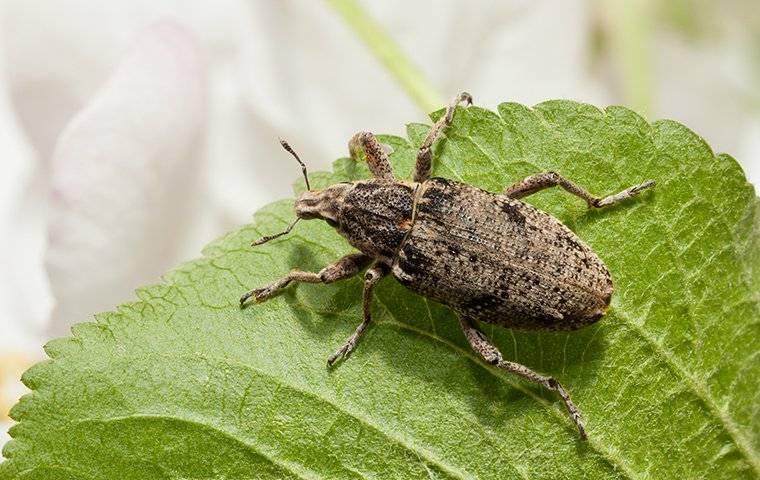
Black Vine Weevil
The dark weevil of the vine is a real nuisance in the nurseries and it rides the plantations of the scene. This species was first announced in Connecticut in 1910. This key insect is the most ruinous and widely appropriated type of root weevil in the Otiorhynchus class. Adults and offspring lean towards rhododendron, Rhododendron spp., Tagus, Taxus spp., Euonymus, Euonymus spp., and Japanese holly, Ilex crenata. The young also eat the underlying hemlock foundations, Tsuga spp. Landscaping managers refer to this creepy crawly as the taxus weevil.

The black weevil of the vine is about 1/5" long and mostly black in color. It is slightly larger than the strawberry root weevil, but the two are difficult to distinguish.
The larvae of the black weevil on the vine feed on the roots of the target plant. Biology and habits are probably similar to those of the strawberry root weevil, but the black weevil of the vine feeds on more different types of plants, including several different varieties of ivy (commonly known as English ivy) in landscaping.
Large amounts of these weevils in an area can severely damage and even kill the affected plants. This weevil cannot fly and disperse by the drag that often brings them wandering in homes and other buildings. In some cases, a large number of weevils can be found crawling on floors, walls, and even ceilings.
Habitat
This weevil is found in many areas of the United States, including most of California. It is a pest of many plants including strawberries, blueberries, rhododendrons, azaleas, yew trees (Taxus spp.), Camellias, many types of ivy, and other plants.
Life Story
These vermin hibernate as young offspring on earth. Development hatchlings are 10-15 mm long and resting form (pupal) cells in the dirt in the early spring. Adults often rise out usually from May to June and in North America just the females are known. They are dynamic nocturnal feeders and when they get worse, adults quickly fall to the ground. In the midst of sunny hours, adults take refuge in dull places on stems of plants with thick foliage or litter and mulch.
Adults require 21 to 28 days of foliage to encourage the creation of eggs. They can lay over 500 eggs over a time of 14-21 days. The eggs are deposited in the dirt near the base of the host plants. They occur in 10-14 days in small pups that feed on roots until temperatures drop in the fall and cause them to move more in the ground where they spend the winter. Sporadically, some adults can survive winter indoors. Just a single era happens every year in Pennsylvania.
How To Prevent/Control
Long-term relief from infestations depends on the homeowner’s willingness to replace those host plants of black vine beetles in landscaping. Short-term relief depends on treatments directed around the building by a pest management professional. Pesticides are toxic. Perused and take after titles and insurance on names. Handle with precision and store in unique marked magazines outside the range of young, domesticated, and domesticated animals. Dispose of the discharge supports immediately, securely and in a place. Try not to disturb the search, streams, or lakes.
Customer Reviews
-
“He spent time educating us about "pests" and provided information regarding services with GoForth.”- Joyce C.
-
“Texted me before coming. Worked with me playing musical rooms with my dogs. I'll see how things are.”- Constance E.
-
“Amazing response time, reasonable prices, great customer service. Tevin was thorough and confident in his plan to fix our horrendous fire ant problem. We have had negative experiences with prior exterminators and probably waited way too long to call Go-For”- Ashley T.
-
“- Toya B.
We have been customers for almost 7 years for a reason. Our technician is the best. He always knows exactly how to address whatever pest has decided to bother us. We have referred them to many of our neighbors. Well worth the cost not to have to worry a
” -
“Answered all my questions and I felt their pricing was very reasonable.”- Deborah J.
-
“Brian went above and beyond what was expected, and I hope I get him again as my technician for future services!”- Tam L.
-
“He was thorough with inspecting and treating our home, which I really appreciate, and he took the time to answer my many questions.”- Jasmine B.
-
“Love the detailed summary and pics of what he did and saw! And did I mention how wonderful Olivia was to get us all set up?!!”- Beechy A.


Over the years, we’ve boiled down our mission to a core set of values:
-
Give A CrapDelight others by owning your role and saying yes. Take pride in how you appear & act & every other detail of the job. Be on time, attentive, & enthusiastic. Act as if the buck stops with you on every aspect of the job.
-
Chase PerfectionChase Perfection, knowing full well we will not reach it, but along the way we will catch excellence. Have a sense of urgency; Go-Forth Time - right now might be the only time you have to get it right.
-
Dig Deeper
Be an action-oriented professional that makes decisions based on evidence rather than stories & assumptions. Stay curious. Data can speak for itself.
Understand the cause of the fire rather than rushing to extinguish it.
-
Fight For SimplicityKeep it simple & consistent. Focus on how things should be done every time.
-
Face It, Fix ItConfront challenges directly and address issues head-on. A bias for action and powerful conversations drive our progress. It’s about getting it right rather than being right.
-
Grow!Growth is our purpose. Growing as people & growing our business.